In Peru, self-reporting of oil spills by companies leaves an unknown toll
- In Peru, the oil industry is responsible for monitoring its own spills, but companies have been penalized for providing false and incomplete information.
- Records kept by government agencies of the number of barrels of oil spilled into the environment are full of inaccuracies, leaving the true quantity unknown.
- According to reports from oil companies, 88% of spills in Peru have occurred on the country’s north coast, one of the most biodiverse areas of Peruvian waters.
The first oil well in South America was built more than a century and a half ago, in the district of Zorritos, in northern Peru. Fishermen still tell the story of how the place got its name: locals compared the smell of oil to that of foxes, zorros in Spanish.
Nowadays, there are 1,200 oil wells operating in Tumbes, where Zorritos is located, and in Piura, the two northernmost departments on the Peruvian coast. The wells represented 66% of the country’s oil production in 2018, or almost 12 million barrels, according to annual statistics from Perupetro, the state agency responsible for promoting hydrocarbon exploitation.
The marine area is one of Peru’s most biodiverse. It was to Cabo Blanco, a small bay on the north coast, that Ernest Hemingway and other celebrities and sportspeople came in the 1950s and ’60s in pursuit of monumental fish. Footage shot there of the fight to the death with the biggest black marlin ever recorded, measuring 4 meters (13 feet) long and weighing 708 kilograms (1,560 pounds), was used in the 1960 film version of Hemingway’s novella, The Old Man and the Sea. The enormous marlin is just one element of the region’s marine diversity, which provides half of the country’s fresh fish.
Due to the quantity of oil stored and produced on the north coast, it’s not unusual to see black patches of it spread out across the water, submerging and diluting, contaminating the ecosystem.
Mongabay Latam analyzed official reports of spills and calculated that, in the 10 years between 2009 and 2019, nearly 10,000 barrels of oil were spilled throughout Peru, on land and in the sea. This amounts to 1.5 million liters (409,000 gallons), equivalent to the capacity of 310 tanker trucks.
The great majority of these spills, 88%, took place in the sea off the north coast. However, the actual figures are certainly much higher and no government agency knows the real total.
Regulation in the hands of the oil companies
On Jan. 8, 2014, fishermen from Zorritos reported that U.S.-headquartered BPZ Exploración & Producción spilled crude oil into the sea about 10 kilometers (6.2 miles) from the coast. The fishermen used buckets to collect water near the spill as evidence. They even put their hands in the sea, turning them black.
Before the company got the incident under control, it announced that it was not a spill but a leak. According to BPZ, only a quarter of a barrel of oil had spilled. A whole barrel is equivalent to a little less than 159 liters (42 gallons), enough fuel for the 28-hour drive between Lima and Quito in neighboring Ecuador.
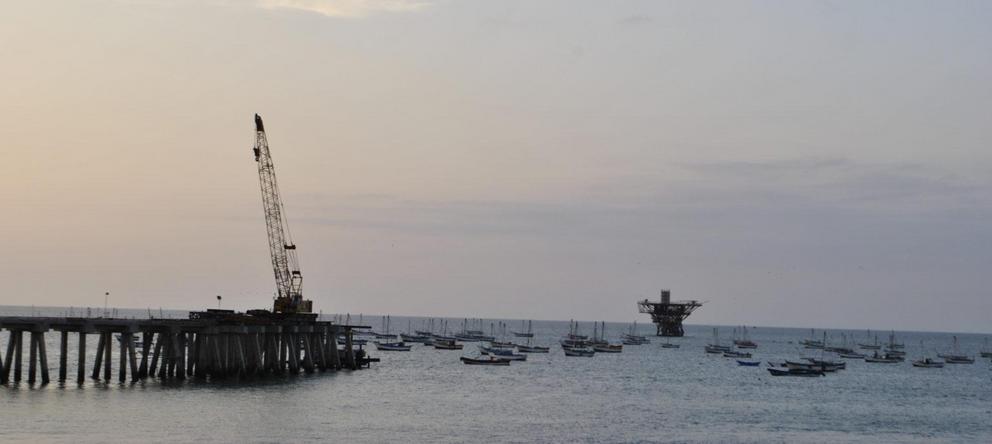 A platform belonging to SAVIA Perú near the coast of Cabo Blanco, in lot Z2B.
A platform belonging to SAVIA Perú near the coast of Cabo Blanco, in lot Z2B.
The accident had occurred when the company was transferring oil from a platform located offshore in lot Z-1 to a tanker via a broken pipe 40 meters (131 feet) underwater. Contrary to the company’s claims, an investigation carried out by Peru’s General Directorate of Captaincies and Coastguards (DICAPI) revealed that the quantity of spilled crude oil amounted to almost 12 barrels. Nevertheless, in their final report to the Environmental Assessment and Control Agency (OEFA), BPZ reiterated that the incident had resulted in the spillage of only 40% of a barrel.
OEFA, noticing the discrepancy, penalized BPZ for providing false information. The penalty notice stated that the quantity spilled could even be greater, considering that 92 barrels of oil were transferred between the platform and the tanker and that the break in the pipe measured 21 centimeters (8.3 inches).
A 40-year-old fisherman, short with a round face, who had spent more than half his life casting his nets off the North Coast, witnessed the spill. “They always report it as smaller because they attempt to hide it,” he told Mongabay Latam. “When the contingency team arrived, they spread chemicals, which made the oil disappear from the surface. Several days later, when we hauled our nets up from the bottom, they were covered in oil. The smell was very strong. It was like that for three or four months.”
The fisherman asked to remain anonymous. He claimed to have seen dozens of spills, describing them as trails that spread out like black threads across the water.
Oil companies are required to report crude oil spills to OEFA and to the Supervisory Agency for Investment in Energy and Mining (Osinergmin). Their reports should include the location, time, reason for the spill, and action taken, as well as the quantity spilled.
Mongabay Latam analyzed Osinergmin’s reports for 2009 to 2019. We calculated that during that period, 9,743 barrels of crude oil, water with oil, liquid hydrocarbon or produced water were spilled on 9,439 separate occasions across the country. That’s equivalent to almost three barrels of crude oil spilled every day for a decade.
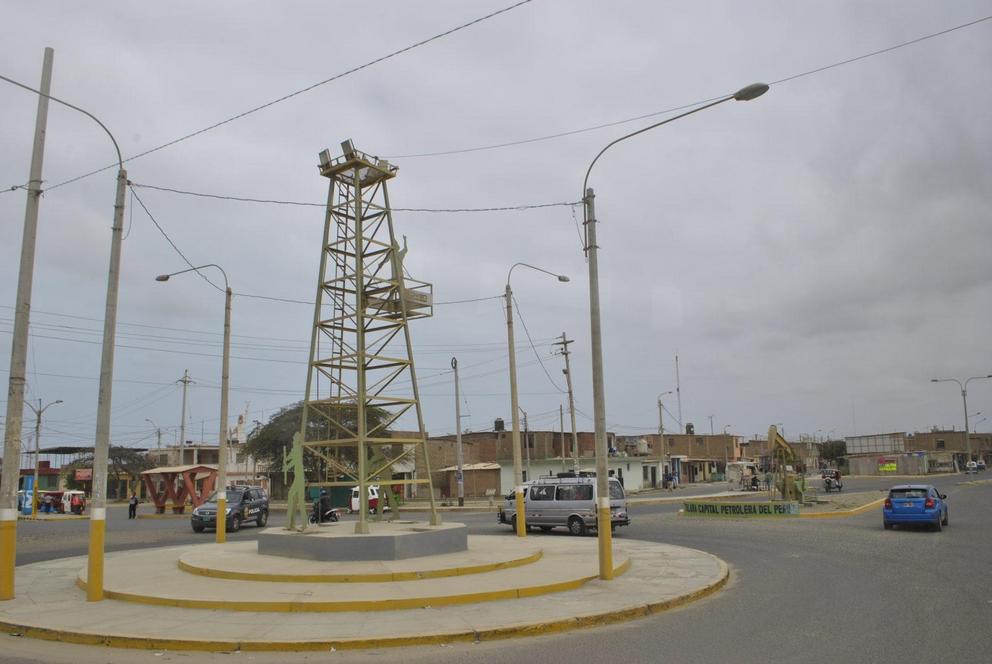 A monument to the oil industry at the entrance to the city of Talara.
A monument to the oil industry at the entrance to the city of Talara.
Of all these spills, 88% took place on the north coast, but oil companies claim in their reports that the figure is only a little more than one-third of that total, the equivalent of 3,104 barrels.
OEFA’s record is more limited in scope than Osinergmin’s. The agency began regulating companies in March 2011 and has since recorded only 631 incidents. Whereas Osinergmin penalizes companies’ operational shortcomings in the energy, hydrocarbon and mining industry, OEFA penalizes environmental damage. Looking at Osinergmin’s records for the years OEFA has been in operation indicates that in 84% of cases OEFA neither penalized companies nor verified the information they provided.
Inaccurate figures
Spills that occur in the sea are not monitored. Neither Osinergmin nor OEFA verify the figures provided by oil companies. This should be the responsibility of DICAPI, which oversees Peru’s ban on dumping waste in the sea.
Between 2013 and 2018, OEFA filed six administrative proceedings against oil companies responsible for marine spills. In two of these it used DICAPI’s reports to penalize the companies for lying about the quantity spilled. In another two, with no DICAPI reports available, it accepted the information provided by the oil companies without questioning it. In the remaining two, the companies failed to provide figures on the quantity spilled and OEFA decided the penalty without this information.
BPZ’s spill, described above, was one of the cases where companies gave false information. The second took place in July 2013, when SAVIA Perú, a Colombian and South Korean oil company, reported a spill of 2.5 barrels, but DICAPI ascertained that the quantity was in fact 48.57 barrels.
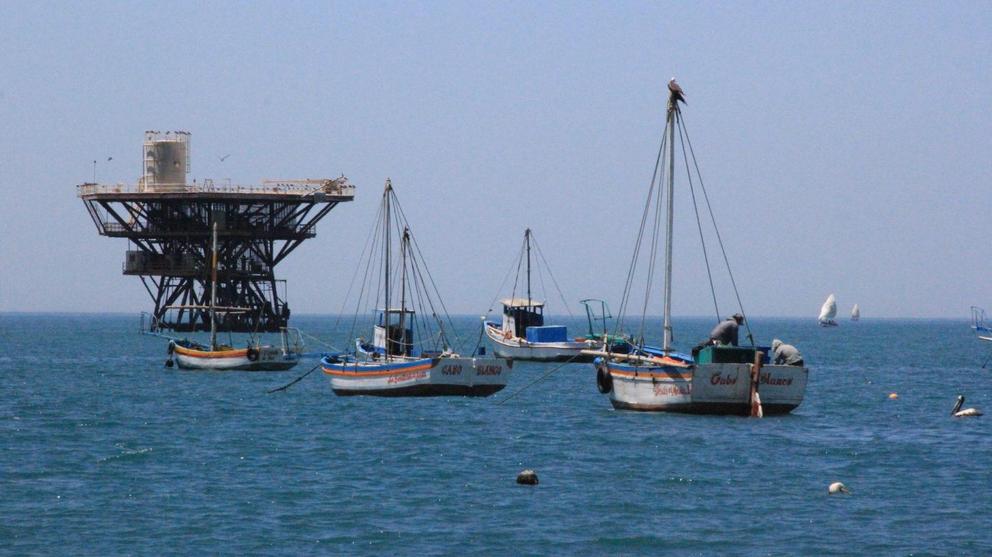 In the area around Cabo Blanco, 25 platforms have been built in lot Z-2B; they are now operated by the Colombian and South Korean company SAVIA Perú.
In the area around Cabo Blanco, 25 platforms have been built in lot Z-2B; they are now operated by the Colombian and South Korean company SAVIA Perú.
The investigation for this report used information from Osinergmin’s databases of small and large incidents, OEFA’s database of environmental emergencies, and the monthly reports oil companies submitted to Osinergmin between 2015 and July 2019. It analysed OEFA’s administrative proceedings penalizing oil spills occurring in Tumbes and Piura between 2009 and October 2018.
These documents frequently lacked information about the quantity of oil spilled. One such case, from Sept. 22, 2014, also involved BPZ. OEFA penalized the company for failing to provide this information, but ultimately excused it due to the paquetazo ambiental, or environmental package, a law in force between 2014 and 2016 that exempted businesses in the productive sector from paying environmental fines. It was not possible to ascertain how much oil was spilled.
On April 3 last year, while on a daily walk, residents of Lobitos, or little wolves, a beach town about 110 kms (68 mi) southwest of Zorritos, noticed a spill that had gone undocumented by both Osinergmin and OEFA. The residents took photographs as evidence, of lot VI, operated by SAPET Development Peru. However, the last minor spill SAPET reported to Osinergmin was in September of the previous year.
OEFA, for its part, was monitoring SAPET on the same day that the residents of Lobitos took the photos, but in Pariñas, a nearby district. According to the OEFA inspectors’ minutes, while they were there they did not find “any evidence that [constituted] administrative offenses.”
 An oil spill from a pipe in lot VI. Image by residents of Lobitos.
An oil spill from a pipe in lot VI. Image by residents of Lobitos.

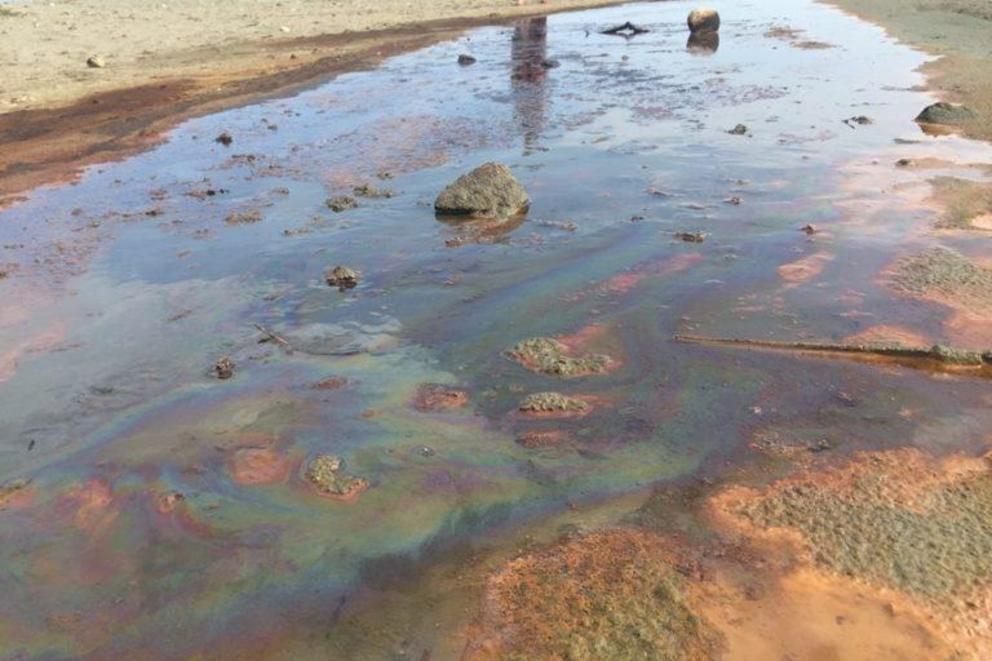
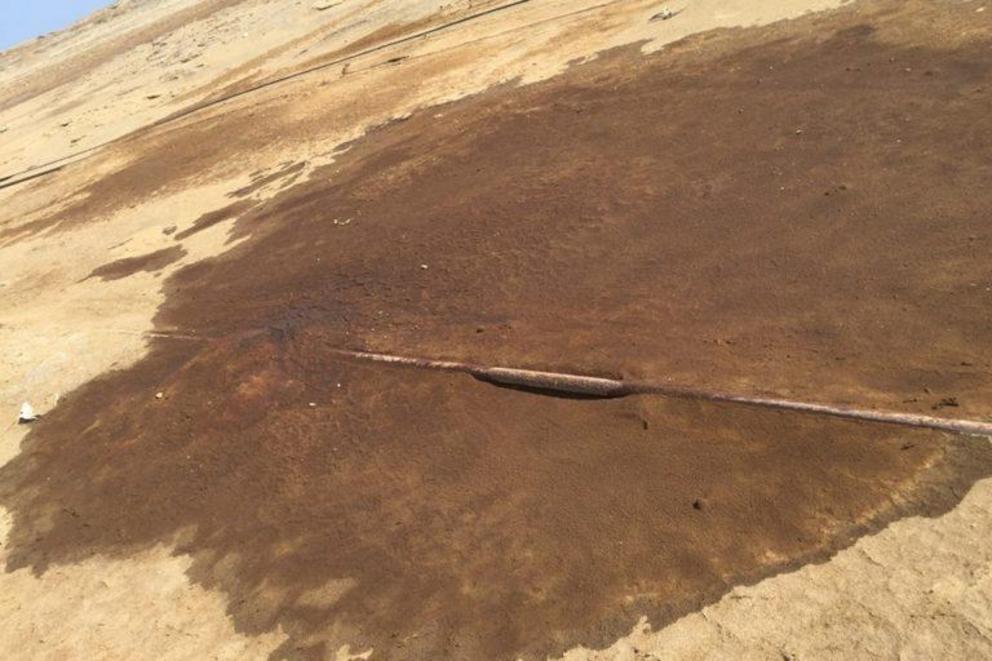
Osinergmin’s database is full of “zero” records due to companies’ self-regulation. This does not indicate an absence of spills, but spills of quantities less than one barrel. Between January and July of 2019, 21 of the 69 spills reported were recorded as “zero.”
Osinergmin told Mongabay Latam that it is now asking for precise data to prevent more zeros in the future.
Combined with the technical and human difficulties of calculating the true quantity of oil spilled, the government’s faith in oil companies to provide information about spills for which they are responsible has resulted in an inaccurate record of the quantity of oil spilled into the environment. The reported 3,104 barrels spilled into the sea, which does not account for DICAPI’s corrections, is only a hint at the real amount.
As proof of the inaccuracy of the reports, the congressional commission responsible for investigating oil spills from the country’s longest pipeline, the 1,106-km (687-mi) North Peruvian Pipeline, concluded in 2017 that in the Amazon alone, 25,000 barrels were spilled between 2008 and 2016. This amount does not coincide with the amount reported by oil companies. According to the reports sent to Osinergmin, over the 10 years from 2009 to 2019 the total quantity of spills in the entire country amounted to fewer than 10,000 barrels of crude oil, water with oil, liquid hydrocarbon or produced water.
Oil’s journey in the sea
Gregorio Eche, who guards Lobitos Beach, is a thin 80-year-old man who said he is tired of talking about pollution and the declining fish population. There are four oil concessions in Lobitos district: lot X, operated by China National Petroleum Corporation (CNPC), in the north of the district; lot XV, operated by Petrolera Monterrico, in the center; lot VI, operated by SAPET, a subsidiary of CNPC, in the south; and lot Z-2B, operated by SAVIA, situated offshore.
“Thank God the sea cleans itself,” Eche said. “The waves take out what isn’t good. It’s not the same in rivers, where spills are a tragedy.” His hypothesis has support among residents of the bay, but while it’s true that the sea naturally breaks down oil, it’s not as simple as leaving it to the waves.
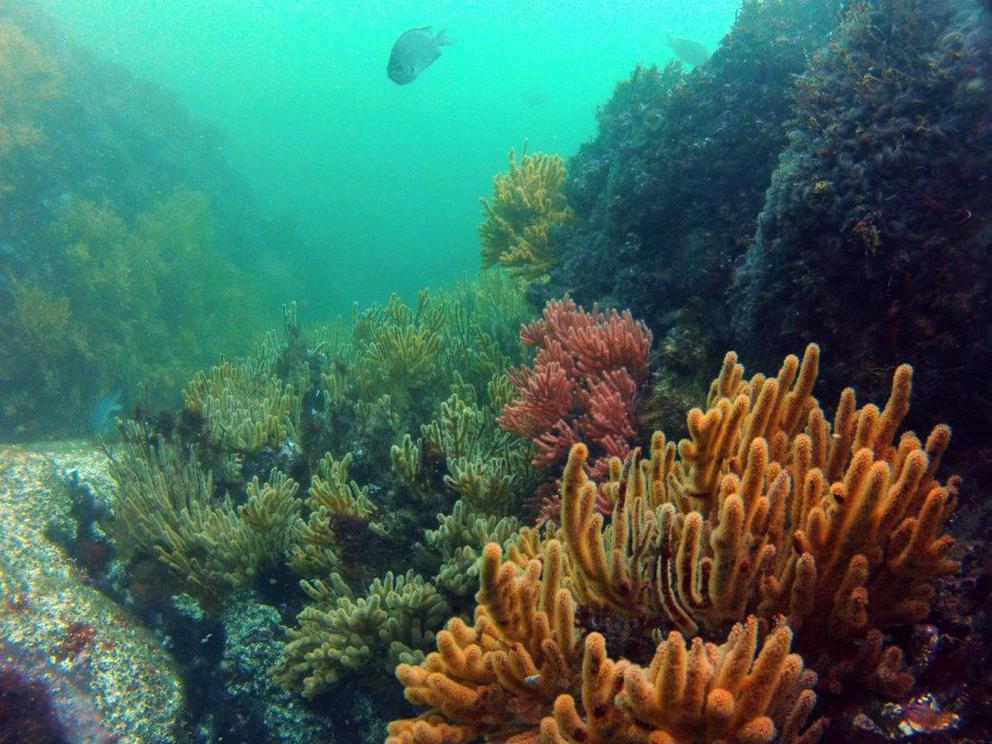 The most abundant biodiversity in this area is under the water’s surface. The reefs of Punta Sal are home to a large number of endemic invertebrates.
The most abundant biodiversity in this area is under the water’s surface. The reefs of Punta Sal are home to a large number of endemic invertebrates.
Andrea Collantes, a marine biologist and consultant who specializes in oil spills, said that after oil spills into the sea it eventually sinks. First, its lighter components evaporate or dissolve while the heavier ones undergo a process of oxidation until they become sediments. While on the surface, the oil blocks sunlight, preventing it from reaching the phytoplankton below. The movement of the sea also breaks it down into small black bubbles that gradually decompose.
Fish and other organisms may consume these bubbles, Collantes said. Those that survive the contamination enter the food chain and can eventually reach the dinner tables of Peruvian families. Scientific studies show that spills not only result in mass mortality of marine organisms, but also the bioaccumulation of oil components in organisms further up the food chain.
Collantes said the movement of the sea can bring sunken hydrocarbon bubbles back to the surface so they can evaporate, but there is always a risk that some of the oil will sink into the sediments at the bottom.
The frequency of spills on the north coast is key: the problem with oil pollution is when the quantity of hydrocarbons is greater than the capacity of the sea to break it down.
Brazil’s Petrobras operated lot X until the end of 2014. In its reports of spills of less than one barrel, it recorded between 100 and 200 incidents a month and 10 to 30 incidents a day, according to the data the company provided to Osinergmin. No other oil company has reported with this level of detail.
Need to quantify
Studies show that oil in the sea can have various effects on marine animals. For example, two reports published by the Marine Institute of Peru (IMARPE) state that hydrocarbons adhere to fishes’ gills and marine mammals’ respiratory tracts, affecting their breathing, and that marine organisms can suffer deformities, loss of fertility and reduced hatching of eggs. Mussels and other mollusks can lose their ability to adhere to rocks and therefore their ability to feed themselves.
Spills can also negatively affect fisheries; some fish species vary their migratory patterns if they detect oil.
 Gregorio Eche, who guards Lobitos Beach, in his boat, the San José.
Gregorio Eche, who guards Lobitos Beach, in his boat, the San José.
“Fish, like us, have their own system of defense and will try to defend themselves against petroleum components,” said Miguel Ángel Saldaña Serrano, an ecotoxicology researcher with the Laboratory of Biomarkers of Aquatic Contamination and Immunochemistry at the Federal University of Santa Catarina in Brazil. “The fish that do not die will be caught by fishermen and consumed by humans.”
Saldaña said it’s necessary to monitor both water quality and marine species, even after smaller spills, because this information can provide the state and companies with more tools to mitigate the environmental impacts of spills.
In May 1988, the Permanent Commission for the South Pacific, with the support of the United Nations Environment Programme, published maps of critical areas and vulnerable resources in the southeast Pacific, prioritizing their protection against accidental contamination with oil. The most critical area was along Peru’s north coast, between the ports of Paita and Punta Aguja. Even knowing this, the last public monitoring of total petroleum hydrocarbon contamination in the sea was in 2010 and 2008.
The more detailed 2008 publication, by the Marine Institute of Peru, described a “critical situation” in Talara, one of the bays that provides the most fish for human consumption on the north coast. While high, the concentration of aromatic hydrocarbons in water and marine sediments there was still lower than the maximum permitted level, 10 micrograms per liter, established by the International Oceanographic Commission in 1984.
Grau Tropical Marine Reserve
The fisherman who witnessed the BPZ spill in Zorritos and Eche, the Lobitos Beach guard, both said fish are now fewer in number and less diverse along the north coast. The fisherman from Zorritos no longer works on his boat. He has become a motorbike taxi driver, because he can no longer make a living by fishing. “It’s a shame. Both my father and my father’s father were fishermen,” he said.
After the spills in 2014, he said, fish simply “stopped coming,” and for two years “there were no fish at all.” Previously abundant species dwindled, he said: snoek (Thyrsites atun), blue butterfish (Stromateus fiatola), Peruvian weakfish (Cynoscion analis) and humpback smooth-hound (Mustelus whitneyi).
 Punta Sal.
Punta Sal.
Carlos Chapilliquén is president of the fishermen’s guild of El Alto, a region of Piura that in 2017 and 2018 actively condemned spills in lot Z-2B, operated by SAVIA Peru. Chapilliquén also associates the scarcity of fish with contamination by the oil industry. He said species that have disappeared include Peruvian banded croaker (Paralonchurus peruanus), corvina (Cilus gilberti), longfin yellowtail (Seriola rivoliana) and broomtail grouper (Mycteroperca xenarcha).
“We are not going to allow them to carry on scaring away all the fish,” he said of SAVIA. “We put our foot down and told them that they had to get new pipes. The pipes are about 50 years old; you can see this in the photos. The company is now changing all its pipes.”
In April of last year, in Cabo Blanco, where Hemingway fished, an oil spill spread 350 meters (1,150 feet) along the coast. The cause was the erosion of one of SAVIA’s pipes. Residues of hydrocarbon accumulated in puddles under the pipes, and regulators from OEFA, the Talara Port Authority and Osinergmin collected samples in plastic bottles.
Lot Z-2B encompasses the districts of Los Órganos, El Alto, Lobitos, La Brea and Colán — a large part of Piura’s coastline. SAVIA has a long history of receiving penalties from Osinergmin for failing to report spills, and from OEFA for not taking measures to mitigate their environmental impact.
The proposed Grau Tropical Marine Reserve, which would include a section of the north coast, has been in the planning for seven years. Petroleum concessions, Z-2B among them, overlap all four of the separate areas that comprise the would-be reserve. According to the reserve’s technical document, the beaches adjoining lot Z-2B are nesting sites for green sea turtles (Chelonia mydas), an endangered species, and olive ridley sea turtles (Lepidochelys olivacea). Not far to the northeast of Cabo Blanco is El Ñuro, a place that has become famous for allowing tourists to swim with turtles. The stretch of coast between Cabo Blanco and El Ñuro, less than 10 km (6 mi) long, is home to 179 fish species, 95 mollusk species, 46 echinoderm species that include starfish and sea urchins, 12 types of birds, 12 marine mammals, and six types of sponges, not to mention jellyfish, corals and anemones.
 Punta Sal.
Punta Sal.
Pedro Solano, executive director of the Peruvian Society for Environmental Law (SPDA), an NGO, said he believes the authorities will play a more significant role in looking after the ocean once the reserve has been created. This is because the National Service of Natural Protected Areas (SERNANP) will have to approve all operations carried out inside the reserve and an environmental management committee will be established to administer it.
Solano said the government’s regulatory role and mechanisms for monitoring spills will remain the same. “I hope that OEFA will have more direct, immediate access to information concerning the protected area, and that company documents will be easier to evaluate,” he said. “OEFA is currently unable to measure or verify data and this is much more complicated in the sea.”
On Oct. 14, 2019, President Martín Vizcarra inaugurated the third Latin American and Caribbean Congress of Protected Areas (Caplac III), which took place in Lima. During the event the government reiterated its commitment to speeding up the creation of marine protected areas. Meanwhile, from January to July of the same year, companies spilled approximately 20 barrels of oil on the north coast.
Mongabay Latam asked OEFA for records of disciplinary proceedings in which the information provided by the oil industry had been verified, but as of the original publication of this article in Spanish, in November 2019, the agency did not provide a response. SAPET, BPZ, SAVIA and CNPC also did not respond to questions and requests for information.
